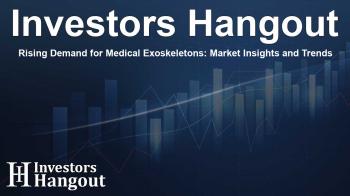Rising Demand for Medical Exoskeletons: Market Insights and Trends

Understanding the Medical Exoskeleton Market's Rapid Growth
As we delve into the fascinating world of the medical exoskeleton market, we find a sector that's not only growing but is also transforming lives. Medical exoskeletons, revolutionary devices designed to assist individuals with mobility challenges, are projected to skyrocket from an estimated value of USD 538.4 million in 2025 to a staggering USD 2,267.2 million by 2032. This represents an impressive compound annual growth rate (CAGR) of 22.8% during this period.
What are Medical Exoskeletons?
Medical exoskeletons are wearable robotic systems that enhance physical capabilities. They assist individuals who experience muscle weakness or have suffered spinal injuries by facilitating mobility tasks such as walking, standing, lifting, and various rehabilitation activities. The demand for these innovative devices is being propelled by increasing incidences of spinal cord injuries, orthopedic conditions, and an aging population.
Market Dynamics Fueling Growth
The dramatic rise in the medical exoskeleton market can be attributed to several key factors. One of the most significant drivers is the increasing number of people living with disabilities and neurological disorders. According to health experts, the prevalence of conditions like stroke, multiple sclerosis, and Parkinson’s disease is on the rise, creating a heightened demand for assistive technologies.
Supporting Rehabilitation and Mobility
Medical exoskeletons are engineered to enhance human movement and support rehabilitation outcomes. Equipped with a combination of structural components, sensors, motors, and actuators, these devices mimic and assist human motion. They play a critical role in rehabilitation, helping individuals regain mobility and improve their overall quality of life.
Challenges in the Market
Despite the optimistic outlook for growth, the medical exoskeleton market faces several challenges. High costs of advanced exoskeletons can hinder accessibility for many patients, while rigorous regulatory processes delay the introduction of new products to the market. These hurdles can stifle market expansion and limit the availability of these life-changing devices for those who need them most.
Innovations and Opportunities Ahead
Innovation is ushering in new growth opportunities for the medical exoskeleton market. Companies are increasingly focusing on integrating AI, IoT, and lightweight materials to enhance the functionality and user-friendliness of these devices. Developments in battery technology and wearable design are making medical exoskeletons more appealing and accessible to users, potentially boosting market value significantly in the near future.
The Role of AI in Medical Exoskeleton Advancements
Artificial intelligence (AI) is revolutionizing the medical exoskeleton landscape. This technology allows exoskeletons to adjust in real-time based on user intentions, significantly improving safety during rehabilitative processes. AI-driven monitoring systems enable healthcare professionals to track patient progress remotely, thus expanding rehabilitation support beyond traditional settings.
Demographic Trends Influencing Demand
As the global population ages and the number of individuals with mobility impairments rises, the demand for medical exoskeletons is expected to increase significantly. Elderly populations are particularly vulnerable to conditions like osteoporosis and arthritis, which necessitates better rehabilitation solutions. Additionally, a surge in spinal cord injury cases also contributes to the growing market as individuals seek improved mobility assistance.
Future Directions in the Medical Exoskeleton Market
Looking ahead, there is a clear trend towards the development of mobile exoskeletons as companies strive to address the evolving needs of users. Innovations are also geared towards creating robust exoskeletons suitable for home care environments, which could drive the market's growth further.
Valuable Insights from Industry Experts
Industry analysts are optimistic about the future of the medical exoskeleton market. They emphasize that rising incidences of neurological disorders, coupled with advancements in robotic rehabilitation technologies, are key to ongoing market expansion.
Frequently Asked Questions
What is driving the growth of the medical exoskeleton market?
The growth is primarily driven by rising incidences of spinal cord injuries, neurological disorders, and an aging population requiring mobility assistance.
What are the main types of medical exoskeletons?
Medical exoskeletons can be categorized into lower body, upper body, and full-body exoskeletons, each serving different rehabilitation needs.
How is AI impacting the medical exoskeleton market?
AI improves exoskeleton functionality by enabling real-time adjustments that enhance user safety and rehabilitation effectiveness.
What challenges does the medical exoskeleton market face?
High costs and rigorous regulatory approval processes are significant barriers to market growth.
What opportunities exist for innovation in this sector?
There are ample opportunities for advancements in technology, including lightweight materials and enhancements in battery life for greater accessibility and user-friendliness.
About The Author
Contact Evelyn Baker privately here. Or send an email with ATTN: Evelyn Baker as the subject to contact@investorshangout.com.
About Investors Hangout
Investors Hangout is a leading online stock forum for financial discussion and learning, offering a wide range of free tools and resources. It draws in traders of all levels, who exchange market knowledge, investigate trading tactics, and keep an eye on industry developments in real time. Featuring financial articles, stock message boards, quotes, charts, company profiles, and live news updates. Through cooperative learning and a wealth of informational resources, it helps users from novices creating their first portfolios to experts honing their techniques. Join Investors Hangout today: https://investorshangout.com/
The content of this article is based on factual, publicly available information and does not represent legal, financial, or investment advice. Investors Hangout does not offer financial advice, and the author is not a licensed financial advisor. Consult a qualified advisor before making any financial or investment decisions based on this article. This article should not be considered advice to purchase, sell, or hold any securities or other investments. If any of the material provided here is inaccurate, please contact us for corrections.

